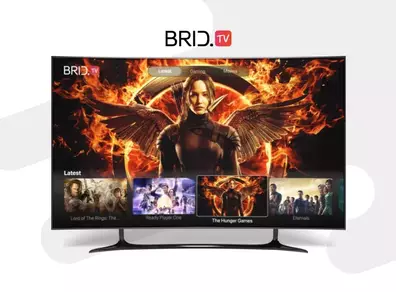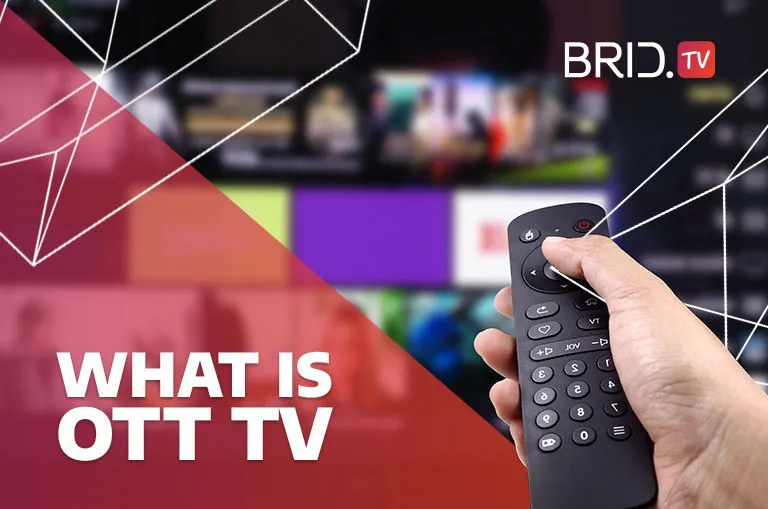In today’s fast-paced age of innovation, it’s not unusual for new technologies and trends to pop up seemingly overnight. That happened to be the case with OTT TV.
Traditional, linear television companies weren’t ready for the sudden rise of over-the-top television, which proved superior in many ways. Delivering video on demand over the internet was more effective than distributing content via cable or satellite. That led to nearly all Americans between 25 and 34 cutting the cord in favor of online content delivery.
The rise of OTT technology also solved one of TV consumers’ biggest pain points — accessibility. People can now choose where and how they want to consume video content. Whether you prefer to enjoy your favorite shows on your widescreen Smart TV or your mobile phone or tablet, you can do so without much hassle.
OTT TV gets video content where people want to watch it.
That is why many new companies and content providers are entering the OTT market daily in hopes of reaping the benefits of the OTT craze.
But what if you’re a latecomer? Is it still worth entering the OTT race? Who is investing in the market, and how are they making money? How does this technology even work? These are just some of the questions we are going to answer in this article.
But let’s not get ahead of ourselves. We should first cover the basics.
What Is OTT TV
OTT TV or over-the-top television entails all video content that reaches the end-user via the internet in favor of delivery by cable or satellite. That allows viewers to watch on-demand video content from any device with an internet connection (Smart TV, phone, tablet, etc.). Thanks to the popularization of OTT, consumers don’t have to subscribe to monthly cable or satellite TV services to stream their favorite content.
OTT TV is also known as online television, internet television, or streaming television.
Although some OTT services come with subscription fees, there are free options out there too. This freedom of choice is what put OTT in front of over 2.13 billion people worldwide. When you add to that the fact that you can access OTT content from almost anywhere nowadays, it becomes abundantly clear why traditional television lost most of its appeal.
How Does OTT TV Work
Although OTT technology is still young, it developed a lot over the last few years, thanks to the innovativeness of Smart TVs. Most television sets nowadays even come with OTT-ready remotes regardless of whether consumers are using any OTT services.
But how do OTT platforms operate, and how does the content reach the end-user?
All OTT content reaches users over the internet, but how that happens varies. There are two primary ways of delivering OTT content:
- Through an OTT device.
- Through an OTT app.
OTT devices are usually small router-like boxes that users can connect to their TVs to facilitate video content delivery over the internet. Some of the most well-known OTT devices are Apple TV Box and Roku Streaming Stick.
Related: What Is an OTT Box and How to Use It
The alternative way of delivering OTT content is through a dedicated OTT TV app. Users can simply download them on their TVs and don’t need any hardware to start streaming content.
But regardless of the delivery method providers use, all OTT content relies on a complex OTT backend.
An online video platform is usually the centerpiece of an OTT backend and handles all user subscriptions, security, media storage, and usage rights of an OTT platform. It also takes care of all communication with user devices (OTT devices, phones, etc.) and content delivery. The OVP in the backend also handles all ad serving if you rely on OTT advertising as your primary source of revenue.

Brands Are Increasingly Investing in OTT Apps
As the OTT market is maturing, more and more OTT streaming providers have been turning from OTT devices to OTT TV apps. Why? Because OTT apps aren’t exclusive to TV — users can also download them on their mobile devices. And considering that 89% of U.S. consumers stream video from their phones, getting into this lucrative market is the logical next step for most brands.
You Might Also Like: OTT vs. CTV — All the Differences Explained
Here are just some of the industry giants who already jumped onto the OTT app bandwagon and are reaping the rewards:

- Netflix — As of 2021, 86.5% of U.S. consumers who watch OTT content regularly are subscribed to Netflix.
- Disney+ — Disney+ reached 106.2 million subscribers in Q2 of 2021, less than two years after its debut.
- NFL — NFL’s viewership soared by 65% since they entered the OTT market.
But it’s not just the big shots that are investing in OTT apps. Many small creators are also finding success in the OTT world.
Whether you’re holding Yoga classes or are a YouTube creator or an Instagram influencer, making your own OTT app can benefit your personal brand. As long as you have an existing audience, you have the potential for a profitable OTT broadcasting business. That applies to all industries and niches!
You Might Also Like: Best OTT Apps to Watch Your Favorite Shows On
How to Make Money From OTT TV
If you decide to take the slice of the lucrative OTT cake, you’ll need to think about making money from it. Fortunately, there are several ways to monetize your OTT TV app so that you can choose the one best suited to your audience’s tastes.
Here are four effective ways to monetize your OTT content:
- By Adopting a Subscription-Based Model — Locking your content behind a monthly subscription fee is currently one of the most popular ways of monetizing OTT content. One of the most famous OTT services that uses the SVOD monetization model is Netflix.
- Through the Power of OTT Advertising — Monetizing videos through ads is one of the most widespread monetization models on the web. That is because it allows publishers to hand out their content for free while still earning from it. Sling TV and Vudu are just two big industry names that rely on the AVOD monetization model.
- By Gating Your Content Behind a Paywall — Making your viewers pay per video watched is a viable approach to OTT monetization for some niches. If you have a dedicated audience and know your content is unique and valuable, opting for TVOD can prove quite lucrative.
- By Launching a Free Ad-Supported TV Streaming Service (FAST) — This monetization model has been gaining a lot of popularity lately and is similar to AVOD. The primary difference is that FAST acts more like traditional TV in that it hosts live, scheduled programming instead of having the flexibility of on-demand watching. Free ad-supported TV is the logical next step for traditional broadcasting companies looking to enter the online world. Two of the most notable examples of services using this model are Pluto TV and Tubi.
Before settling for one of these monetization models for your OTT TV app, don’t forget to do some in-depth audience research. Not all of these models will work well for all audiences and content; if you make the wrong choice, it could come back to bite you down the line.
Are you just starting out your OTT business and don’t have a large audience yet? Settling for AVOD is probably the best choice. Do you have a lot of high-quality content your audience can’t find anywhere else? TVOD is probably the most profitable option for you. Do you want a well-rounded and scalable video monetization model? You should try out SVOD.
Either way, you have plenty of options.
Is It Too Late to Get Into the OTT Industry?
No. Quite the contrary — the OTT industry is still young and unsaturated. That means creators and publishers of all sizes have a chance to make it big if they enter the market promptly. Here are three reasons you should consider doing so yourself:
- There is high demand for OTT TV, and it’s only going to keep increasing.
- Many big media companies have yet to enter the market, meaning the competition is not too steep.
- If you enter the market now, you can get ahead of the competition and establish yourself as one of the industry leaders early on.
OTT TV will undoubtedly be the future of video-on-demand content, and we’re sure you don’t want to be left out. So take the initiative and establish yourself on the market as soon as possible. If you already have an online video or publishing business, you’re only one step away from that goal.
The easiest way to enter the market and reach broader audiences is to launch an OTT app. That may sound daunting, but don’t worry; anyone can do it without much hassle.
There are plenty of OTT solutions and app builders out there that can help publishers enter the market without much hassle.
If you plan to launch an AVOD OTT app, Brid.TV can help you. Our Android, iOS, and tvOS SDKs allow publishers to integrate our video platform and HTML5 player with your OTT app seamlessly. Publishers can then use our platform’s advanced advertising features to monetize across various OTT devices (Apple TV, Samsung TV, Roku, etc.)
Check out our OTT solutions and launch a branded OTT app today.


